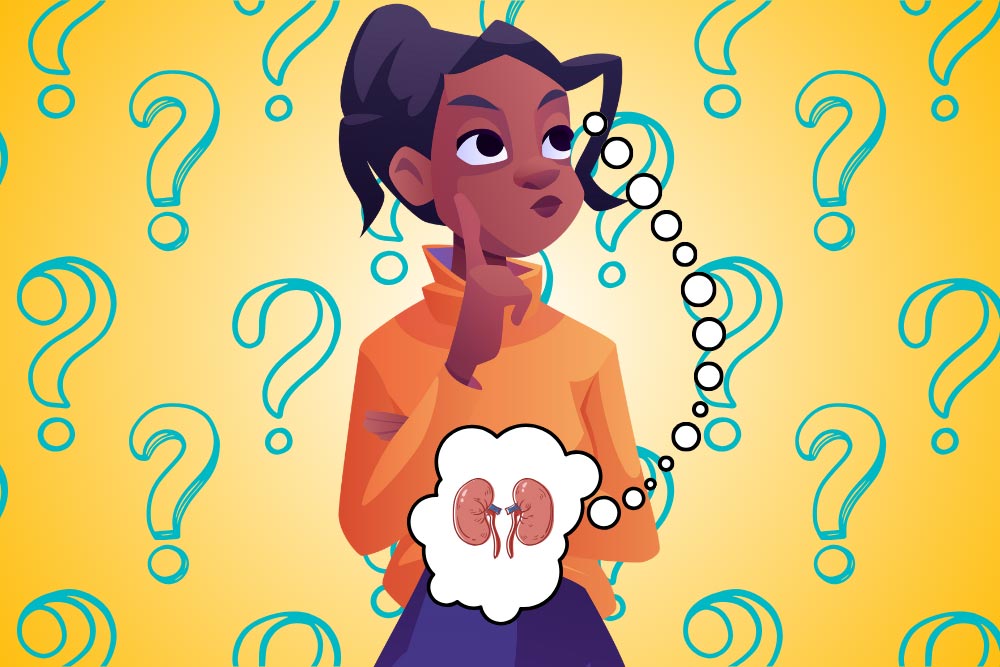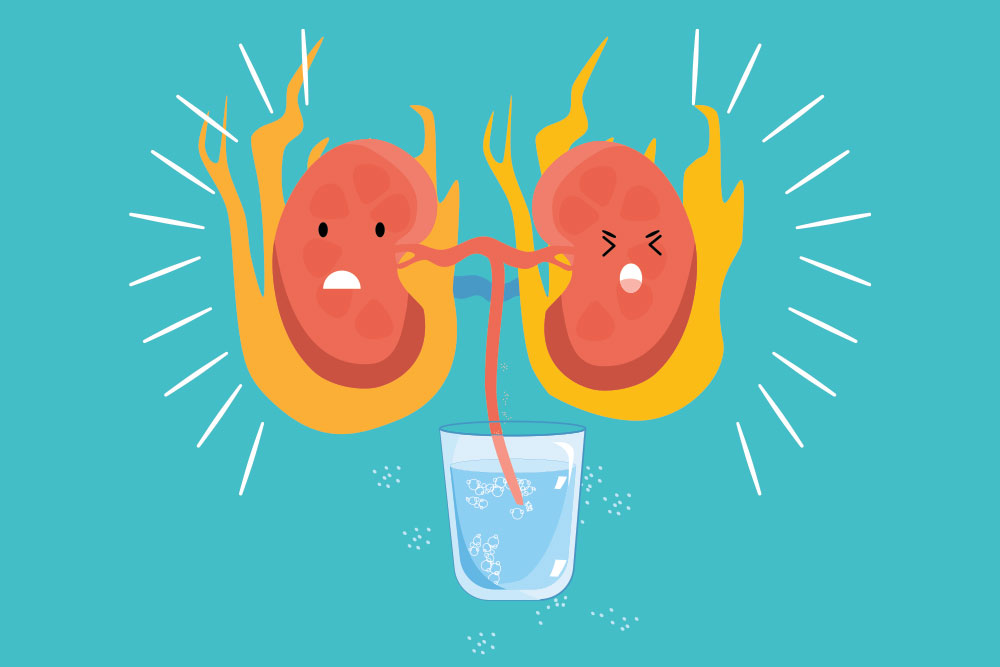GRID VIEW
Most of us have two kidneys. They are fist-sized and shaped like, um, kidney beans. The kidneys filter blood, but it’s more complicated than it sounds. They filter all the blood in the body several times a day. Kidneys differentiate between proteins, cells, minerals, acids, salts, and water. They regulate the amount of small particles to filter out or retain, and they release hormones to regulate blood pressure, red blood cell count, and some aspects of bone growth. To do this, each kidney is packed with tiny filtering units called nephrons (from the Greek word for kidney). Blood goes into these units, where it is separated and filtered by a structure called a glomerulus (from the Latin word for “ball of thread”). The filter has three layers which allow progressively smaller items through. The endothelium blocks cells and other large items. The glomerular basement membrane blocks proteins. The narrowest filter is called the epithelium and is made of special cells called podocytes (from the Greek word for foot). These look like octopi and use their many “legs” to form slits which regulate what gets through. Water, sodium, minerals, and acids are all separated from the blood. The nephrons sense the levels of these items and excrete excess amounts (along with waste products) into the urine. The pressure across the filter heavily influences filtering, so the kidneys have a system to regulate the blood pressure in the nephrons. Unfortunately, when kidneys are deformed, damaged, or otherwise can’t filter for a prolonged period we are subject to chronic kidney disease. Chronic kidney disease (CKD) is an enormous problem around the world. At least 13% of the global population (including 37 million Americans) live with chronic kidney disease. It is defined as an abnormality in structure or function for at least three months and is a big driver of cardiovascular disease. In the early stages, people may not have any symptoms; in fact, only around 5% of people with early CKD are aware they have the disease. Advanced CKD presents with myriad debilitating symptoms, including pain in the chest, changes in appetite and urination, headaches and fatigue, shortness of breath, skin issues, concentration issues, and more. Unfiltered blood can increase the amount of inflammation throughout the body. On top of all this is the most dangerous effect: damage to the cardiovascular system. When the kidneys fail to filter effectively, blood clots become more common, blood pressure may change, and the heart and vascular systems suffer. So what causes this to happen? Since chronic kidney disease is diagnosed based on kidney function and not cause, there are many potential culprits, and each patient will have different circumstances. Most risks can be divided into modifiable and non-modifiable. Modifiable risks may be managed through lifestyle or medication. One-third of people with diabetes have CKD. Diabetes may come with excessive glucose in the blood, which damages the blood vessels in the kidneys. High blood pressure, high cholesterol, obesity, and metabolic syndrome are other significant modifiable risk factors. On top of these, heart disease can lead to renal failure (which unfortunately then leads back to more heart disease). Non-modifiable risks include age, family history, and ethnicity. Let’s go a little deeper. When CKD is diagnosed or staged for severity, doctors look at the kidneys’ output. They may measure the amount of albumin, a component of blood, in the urine. High levels (over 30 milligrams in 24 hours) indicate issues. They may also try to measure or estimate the glomerular filtration rate (GFR). The average American starts with a healthy GFR of around 118 milliliters of blood each minute (mL/min), but someone with CKD filters fewer than 60 mL/min. This is the total amount of blood that is filtered per minute. It can be conceptualized as the filtration rate of a single nephron times the total number of nephrons. GFR gives a good indication of what goes wrong in CKD: the number of nephrons decreases significantly. Before we’re born, we have all the nephrons we’ll ever get – around one million per kidney. This is more than we need, and a person with healthy renal (Latin for kidney) function could donate literally half of them without suffering ill effects. We tend to lose nephrons over our lives, but the rest take up the slack. As nephrons are destroyed, the amount that each one filters has to increase. They try to grow and compensate, and they are often successful. With CKD, the compensation fails, and nephrons suffer compounding damage. High blood pressure in the kidneys can cause the filter to let in improper substances. It can also cause the podocytes to detach and clog the nephron. So what can we do? Despite a lot of effort, we have no way to clean the filters or regenerate nephrons (though scientists are trying!). Current best practice is to mitigate the risks posed to other parts of the body, especially the cardiovascular system. Anticoagulants are used to stop clotting in the bloodstream. These come with the unintended side effect of making bleeds worse, so new anticoagulants that target things like FXI are being investigated to make the blood vessels less prone to clots. Other solutions include mitigating inflammation, reducing the effects of excess albumin, and managing medications and complications that may cause a feedback loop with renal distress, like blood pressure and cardiovascular risks. Clinical trials targeting CKD are currently enrolling, so let’s give unfiltered thanks to our kidneys! Staff Writer / Editor Benton Lowey-Ball, BS, BFA
References: Evans, M., Lewis, R. D., Morgan, A. R., Whyte, M. B., Hanif, W., Bain, S. C., … & Strain, W. D. (2022). A narrative review of chronic kidney disease in clinical practice: current challenges and future perspectives. Advances in therapy, 39(1), 33-43. https://pubmed.ncbi.nlm.nih.gov/34739697/ Chen, T. K., Knicely, D. H., & Grams, M. E. (2019). Chronic kidney disease diagnosis and management: a review. Jama, 322(13), 1294-1304. https://www.ncbi.nlm.nih.gov/pmc/articles/PMC7015670/ Lin, L., Tan, W., Pan, X., Tian, E., Wu, Z., & Yang, J. (2022). Metabolic syndrome-related kidney injury: A review and update. Frontiers in Endocrinology, 13, 904001. https://www.frontiersin.org/journals/endocrinology/articles/10.3389/fendo.2022.904001/full National institute of Diabetes and Digestive and Kidney Diseases. National Institutes of Health. (October, 2016). Chronic Kidney Disease. U.S. Department of Health and Human Services https://www.niddk.nih.gov/health-information/kidney-disease/chronic-kidney-disease-ckd Puy, C., Rigg, R. A., & McCarty, O. J. (2016). The hemostatic role of factor XI. Thrombosis research, 141, S8-S11. https://www.ncbi.nlm.nih.gov/pmc/articles/PMC6135087/ Romagnani, P., Remuzzi, G., Glassock, R., Levin, A., Jager, K. J., Tonelli, M., … & Anders, H. J. (2017). Chronic kidney disease. Nature reviews Disease primers, 3(1), 1-24. https://www.nature.com/articles/nrdp201788
Listen to the article here:
Imagine if your plumbing stopped up. Not your toilets, but your sink and shower. How would you get rid of the dirt and junk off your skin? How would you make sure you stay clean? Our kidneys ask this question every day. The blood in our body travels around and around, including the critical filtration stage of the kidneys. The kidneys act as a big two-way filter. Impurities and excess minerals or water are extracted from the blood, and necessary minerals or water are added as needed. The kidneys keep the ingredients of blood at healthy levels. Finally, kidneys get rid of waste products and extra water by producing urine. When this goes wrong, your blood can’t function properly and waste products can build up. When dealing with the kidneys, you may see three terms thrown about. The origin of “kidney” is unknown, but likely English. “Renal” is the Latin word for kidneys, and the prefix “nephro-” is Greek in origin. If you see any of these terms you can bet we’re dealing with the kidneys. With this in mind, when the kidneys fail to perform their job, we call it renal insufficiency. There are two major divisions in how the kidneys fail, based on the amount of time. There are several possible causes of renal impairment. The vast majority of causes are “upstream,” meaning something affects the blood before it gets to the kidneys. In acute cases, this can be hypotension – not enough fluid, some drugs, such as NSAIDs, or organ failure. When there isn’t enough fluid in the bloodstream, the kidneys compensate by releasing more water, which can deplete the kidney’s reserves and cause failure. In chronic kidney disease, the most frequent cause is diabetes, especially type 2. Prolonged hypertension, and vascular diseases can also be the culprit. With chronic cases, the kidneys will do their best to compensate – constantly filtering out excess blood sugar, for instance. Over time, the excess sugar damages the blood vessels in the kidneys. Some parts of the kidneys may fail and the remaining portions get stressed and eventually decompensate. This is when the kidney fails as an organ. Other possible causes of renal impairment are contained in the kidneys and “downstream” blockages. The kidneys themselve can be the victim of disease or injury, possibly due to long term upstream stress. The ability of the kidney to release urine can also -in rare cases – be disrupted. Regardless of the cause, renal impairment is very dangerous. The kidneys are responsible for keeping blood healthy. A failure of the renal system can result in a need for dialysis or transplant. Dialysis is when external technology filters blood and maintains levels. This is uncomfortable, cumbersome, and expensive. Fixing renal impairment can be a tall order. The most important step is usually treating the underlying cause. Since the kidneys filter several drugs out of the bloodstream, stopping or replacing them may be key. Fluids may need to be replaced in acute cases, and lifestyle changes may be needed in chronic ones. Maintaining healthy blood sugar levels can be key if the root cause is diabetes. For heavily progressed chronic renal impairment, dialysis or transplant may be the only options. Transplant and dialysis are not fun, so we should try to avoid renal impairment before it starts. Many of the tactics to keep your kidneys healthy are the same to keep the rest of your body healthy. Exercise, not overindulging on sugar, and keeping your diet under control can help. Additionally, maintaining a healthy blood pressure is vital. Finally, lowering or cutting out tobacco and alcohol can help keep your kidneys healthy. When it comes to filtering your blood, give your kidneys every advantage you can! By Benton Lowey-Ball, BS Behavioral Neuroscience
Adapted from: Bindroo, S., & Rodriguez, Q. BS; Challa, HJ Renal Failure. (February 24, 2022). StatPearls; StatPearls Publishing: Treasure Island, FL, USA. https://www.ncbi.nlm.nih.gov/books/NBK519012/
Listen to the article here:






